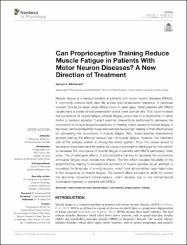| dc.contributor.author | Mohamed, Ayman A. | |
| dc.date.accessioned | 2019-12-14T17:22:05Z | |
| dc.date.available | 2019-12-14T17:22:05Z | |
| dc.date.issued | 2019 | en_US |
| dc.identifier.issn | 1664-042X | |
| dc.identifier.uri | https://hdl.handle.net/11363/1535 | |
| dc.description.abstract | Muscle fatigue is a serious problem in patients with motor neuron diseases (MNDs). It commonly disturbs both daily life activity and rehabilitation tolerance. A particular concern should be taken when MNDs occur in older ages. Older patients with MNDs usually have a worse clinical presentation and a lower survival rate. This could increase the occurrence of muscle fatigue. Muscle fatigue occurs due to a dysfunction in either motor or sensory systems. Current exercise interventions performed to decrease the occurrence of muscle fatigue focused only on treating motor causes of muscle fatigue. It has been demonstrated that these interventions have a high debate in their effectiveness on decreasing the occurrence of muscle fatigue. Also, these exercise interventions ignored training the affected sensory part of muscle fatigue, however, the important role of the sensory system in driving the motor system. Thus, this review aimed to develop a novel exercise intervention by using proprioceptive training as an intervention to decrease the occurrence of muscle fatigue in patients with MNDs particularly, older ones. The physiological effects of proprioceptive training to decrease the occurrence of muscle fatigue could include two effects. The first effect includes the ability of the proprioceptive training to increase the sensitivity of muscle spindles as an attempt to normalize the firing rate of alpha-motoneurons, which their abnormalities have major roles in the occurrence of muscle fatigue. The second effect includes its ability to correct the abnormal movement-compensations, which develop due to the biomechanical constraints imposed on patients with MNDs. | en_US |
| dc.language.iso | eng | en_US |
| dc.publisher | FRONTIERS MEDIA SA, AVENUE DU TRIBUNAL FEDERAL 34, LAUSANNE, CH-1015, SWITZERLAND | en_US |
| dc.relation.isversionof | 10.3389/fphys.2019.01243 | en_US |
| dc.rights | info:eu-repo/semantics/openAccess | en_US |
| dc.rights | Attribution-NonCommercial-NoDerivs 3.0 United States | * |
| dc.rights.uri | http://creativecommons.org/licenses/by-nc-nd/3.0/us/ | * |
| dc.subject | motor neuron diseases | en_US |
| dc.subject | muscle fatigue | en_US |
| dc.subject | older patients | en_US |
| dc.subject | proprioceptive | en_US |
| dc.subject | training | en_US |
| dc.subject | AMYOTROPHIC-LATERAL-SCLEROSIS | en_US |
| dc.subject | NEUROMUSCULAR-JUNCTION | en_US |
| dc.subject | SPINDLE SENSITIVITY | en_US |
| dc.subject | INTENSITY EXERCISE | en_US |
| dc.subject | PERCEIVED EXERTION | en_US |
| dc.subject | ALS PATIENTS | en_US |
| dc.subject | MOUSE MODEL | en_US |
| dc.subject | AGE | en_US |
| dc.subject | MECHANISMS | en_US |
| dc.subject | SYSTEM | en_US |
| dc.subject | Medicine | en_US |
| dc.title | Can Proprioceptive Training Reduce Muscle Fatigue in Patients With Motor Neuron Diseases? A New Direction of Treatment | en_US |
| dc.type | article | en_US |
| dc.relation.ispartof | FRONTIERS IN PHYSIOLOGY | en_US |
| dc.department | Sağlık Bilimleri Yüksekokulu | en_US |
| dc.identifier.volume | 10 | en_US |
| dc.identifier.startpage | 1 | en_US |
| dc.identifier.endpage | 11 | en_US |
| dc.relation.publicationcategory | Makale - Uluslararası Hakemli Dergi - Kurum Öğretim Elemanı | en_US |



















